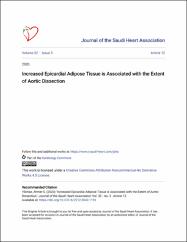Increased epicardial adipose tissue is associated with the extent of aortic dissection

View/
Access
info:eu-repo/semantics/openAccessDate
2020Author
Emlek, NadirYılmaz, Ahmet Seyda
Özer, Savaş
Gündoğdu, Hasan
Durakoğlugil, Murteza Emre
Çetin, Mustafa
Metadata
Show full item recordCitation
Emlek, N., Yilmaz, A. S., Özer, S., Gündoğdu, H., Durakoğlugil, M. E., & Çetin, M. (2020). Increased Epicardial Adipose Tissue is Associated with the Extent of Aortic Dissection. Journal of the Saudi Heart Association, 32(3), 415–420. https://doi.org/10.37616/2212-5043.1193Abstract
Background: Epicardial adipose tissue (EAT) is a biologically active organ that has endocrine and paracrine functions. Endothelial dysfunction, systemic, and local inflammatory response, due to bio-active molecules produced by EAT, may affect aortic dissection propagation and extent. We investigated the association between EAT thickness and the extent of aortic dissection. Methods: We retrospectively enrolled 78 patients with aortic dissection diagnosed by thoracoabdominal Computerized Tomography (CT). EAT was measured from the thickest part of the perpendicular plane between the pericardium and free wall of the right ventricle using CT. Aortic dissection length was measured from the beginning to the end of the dissection flap at sagittal images. Results: We included 78 patients with the mean age of 63.9 +/- 11.7 and 57 (73.5%) patients were male. Dissection length was correlated positively with EAT (r = 0.409, p < 0.001), body mass index (r = 0.408, p = 0.018), and admission systolic blood pressure (r = 0.830, p = 0.026) whereas an inverse correlation existed between age and dissection length (r = 0.318, p = 0.005). Multivariate analysis identified age and EAT as independent predictors of dissection length. Conclusion: Increased EAT was independently associated with the extent of aortic dissection. We think that either paracrine and endocrine functions of EAT might have contributed to the extent of aortic dissection.

















